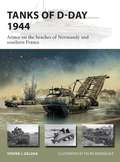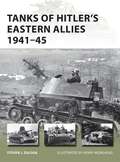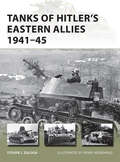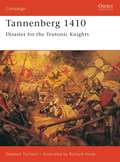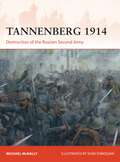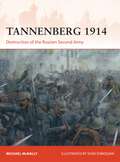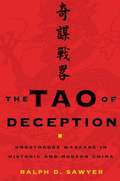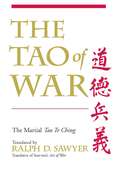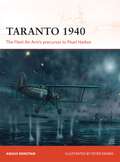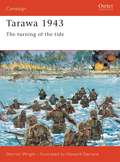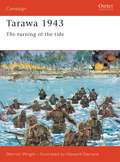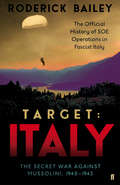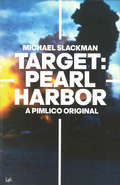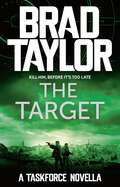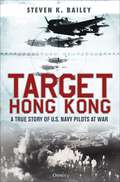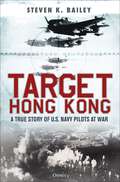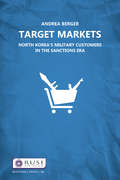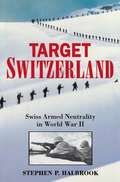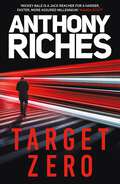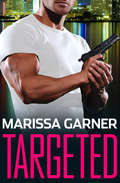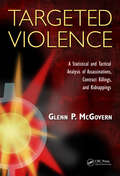- Table View
- List View
Tanks of D-Day 1944: Armor on the beaches of Normandy and southern France (New Vanguard)
by Steven J. ZalogaAllied success in invading Fortress Europe (the area of Continental Europe occupied by Nazi Germany) depended on getting armor onto the beaches as fast as possible. This book explains how the Allies developed the specialist tanks it needed, their qualities, deployment and numbers, and how they performed on the two crucial days when France was invaded, firstly in Normandy and then in Provence. The focus of this volume will be on the specialized tanks developed for the Operation Neptune amphibious landings including the Duplex Drive amphibious Sherman tanks used on both the US and British/Canadian beaches. It also covers the specialized engineer tanks called ”Armoured Funnies” of the British 79th Armoured Division and addresses the popular myth that US Army refusal to employ the Armoured Funnies was a principal cause for the high casualties at Omaha Beach. There is also coverage of Operation Overlord's “Forgotten D-Day”, the amphibious landings of Operation Dragoon. This book addresses why there were so few Panzers opposing the landings from the German perspective as well as detailing the extent of German tank/assault gun activity on D-Day.
Tanks of Hitler’s Eastern Allies 1941–45 (New Vanguard)
by Steven J. Zaloga Henry MorsheadThe titanic armor battles of the Russian Front are widely known, but the role of Germany's eastern allies is not as well known. Two of these countries, Romania and Hungary, manufactured their own tanks as well as purchasing tanks from Germany. These ranged from older, obsolete types such as the PzKpfw 35(t) all the way up to the latest and best German vehicles including the Tiger I and Hetzer. These tanks played a frequent role in the battles in southern Russia and Ukraine and were especially prominent in the disaster at Stalingrad where the Red Army specifically chose the weaker Romanian and Hungarian salients for their critical envelopment operation. This New Vanguard will provide a broad survey of the various and colorful tanks used. Besides covering the largest of these Axis tank forces, this book will cover the many smaller and lesser known forces including the Italian contingent in Russia, the Finnish armored force, and the small but interesting armored forces of the Russian Vlasov (RONA), Croatian, Bulgarian and Slovakian armies. This subject is seeing increasing interest in the modeling world; for example Tamiya recently announced a PzKpfw 35 (t) (suitable for Romanian, Slovak armies) a Finnish StuG III, and a Finnish BT-42.
Tanks of Hitler’s Eastern Allies 1941–45 (New Vanguard #199)
by Steven J. Zaloga Mr Henry MorsheadThe titanic armor battles of the Russian Front are widely known, but the role of Germany's eastern allies is not as well known. Two of these countries, Romania and Hungary, manufactured their own tanks as well as purchasing tanks from Germany. These ranged from older, obsolete types such as the PzKpfw 35(t) all the way up to the latest and best German vehicles including the Tiger I and Hetzer. These tanks played a frequent role in the battles in southern Russia and Ukraine and were especially prominent in the disaster at Stalingrad where the Red Army specifically chose the weaker Romanian and Hungarian salients for their critical envelopment operation. This New Vanguard will provide a broad survey of the various and colorful tanks used. Besides covering the largest of these Axis tank forces, this book will cover the many smaller and lesser known forces including the Italian contingent in Russia, the Finnish armored force, and the small but interesting armored forces of the Russian Vlasov (RONA), Croatian, Bulgarian and Slovakian armies. This subject is seeing increasing interest in the modeling world; for example Tamiya recently announced a PzKpfw 35 (t) (suitable for Romanian, Slovak armies) a Finnish StuG III, and a Finnish BT-42.
Tannenberg 1410: Disaster for the Teutonic Knights (Campaign)
by Stephen Turnbull Richard HookBy 1400 the long running conflict between the Order of Teutonic Knights and Poland and Lithuania was coming to a head, partly as a result of the Order's meddling in the internal politics of its neighbours. In June 1410 King Wladislaw Jagiello of Poland invaded the Order's territory with a powerful allied army including all the enemies of the Teutonic Knights – Poles, Lithuanians, Russians, Bohemians, Hungarians, Tartars and Cossacks. This book recounts how, when the armies clashed on the wooded, rolling hills near the small village of Tannenberg, the Teutonic Knights suffered a disastrous defeat from which their Order never recovered.
Tannenberg 1914: Destruction of the Russian Second Army (Campaign)
by Michael McNallyExplore the Eastern Front battle that resulted in one of the greatest defeats of World War I, in which an entire Russian army was annihilated by German arms.Tannenberg is a major battle that deserves a fully illustrated treatment all of its own, and for the first time this book brings the epic Eastern Front clash to life in visual detail. No other book on this topic walks you through the action like this one, using detailed maps to provide unit locations and movements and help explain key command decisions, while period photographs and colour battlescenes put soldiering back at the core of the events by revealing the military material culture of the opposing sides. Michael McNally guides you through the initial border engagements and the battles of Gumbinnen and Stallupönen, before moving on to explore the massive, often confused running battle of Tannenberg in easy to follow and concise detail. This work helps you understand how the Germans managed to maul Samsonov's Second Army and all but destroyed the Russians as a fighting force. The Russian war plan of using overwhelming numbers to gain a quick victory before conducting further operations would soon lie in pieces on the ground. It also assesses the contribution modern technology – such as railways, aerial reconnaissance, radio and telegraphy – made to the emphatic German victory.
Tannenberg 1914: Destruction of the Russian Second Army (Campaign)
by Michael McNallyExplore the Eastern Front battle that resulted in one of the greatest defeats of World War I, in which an entire Russian army was annihilated by German arms.Tannenberg is a major battle that deserves a fully illustrated treatment all of its own, and for the first time this book brings the epic Eastern Front clash to life in visual detail. No other book on this topic walks you through the action like this one, using detailed maps to provide unit locations and movements and help explain key command decisions, while period photographs and colour battlescenes put soldiering back at the core of the events by revealing the military material culture of the opposing sides. Michael McNally guides you through the initial border engagements and the battles of Gumbinnen and Stallupönen, before moving on to explore the massive, often confused running battle of Tannenberg in easy to follow and concise detail. This work helps you understand how the Germans managed to maul Samsonov's Second Army and all but destroyed the Russians as a fighting force. The Russian war plan of using overwhelming numbers to gain a quick victory before conducting further operations would soon lie in pieces on the ground. It also assesses the contribution modern technology – such as railways, aerial reconnaissance, radio and telegraphy – made to the emphatic German victory.
The Tao of Deception: Unorthodox Warfare in Historic and Modern China
by Ralph D. SawyerThe history of China is a history of warfare. Wars have caused dynasties to collapse, fractured the thin façade of national unity, and brought decades of alien occupation. But throughout Chinese history, its warfare has been guided by principles different from those that governed Europe. Chinese strategists followed the concept, first articulated by Sun-tzu in The Art of War, of qi (ch'i), or unorthodox, warfare. The concept of qi involves creating tactical imbalances in order to achieve victory against even vastly superior forces. Ralph D. Sawyer, translator of The Art of War and one of America's preeminent experts on Chinese military tactics, here offers a comprehensive guide to the ancient practice of unorthodox warfare. He describes, among many other tactics, how Chinese generals have used false rumors to exploit opposing generals' distrust of their subordinates; dressed thousands of women as soldiers to create the illusion of an elite attack force; and sent word of a false surrender to lure enemy troops away from a vital escape route. The Tao of Deception is the book that military tacticians and military historians will turn to as the definitive guide to a new, yet ancient, way of thinking about strategy.
The Tao Of War: The Martial Tao Te Ching
by Ralph D. SawyerWang Chen, a ninth-century military commander, was sickened by the carnage that had plagued the glorious T'ang dynasty for decades. "All within the seas were poisoned," he wrote, "and pain and disaster was rife throughout the land." Wang Chen wondered, how can we end conflicts before they begin? How can we explain and understand the dynamics of conflict? For the answer he turned to a remarkable source-the Tao Te Ching. Here is Wang Chen's own rendering of and commentary on the ancient text, insightfully expanded and amplified by translator Ralph D. Sawyer, a leading scholar of Chinese military history.Although the Tao long influenced Chinese military doctrine, Wang Chen's interpretations produced the first reading of it as a martial text-a "tao of war." Like Sun-tzu's Art of War, certainly the most famous study of strategy ever written, the Tao provides lessons for the struggles of contemporary life. In the way that the ancient Art of War provides inspiration and advice on how to succeed in competitive situations of all kinds, even in today's world, Wang Chen's The Tao of War uncovers action plans for managing conflict and promoting peace. A book to put on the shelf next to Art of War, Wang Chen's The Tao of War is a reference of equally compelling and practical advice.
Taranto 1940: The Fleet Air Arm’s precursor to Pearl Harbor (Campaign #288)
by Peter Dennis Angus KonstamThe Royal Navy's attack on Taranto in 1940 heralded a new age of warfare. It was the decisive moment in a struggle for dominance of the Mediterranean that had gone on for months, as the British and Italian navies both looked to secure maritime supply routes for their colonies. With the enormous demands of a global war beginning to tell, the British capital ships were simply too thinly spread for a large fleet action against Taranto, where the bulk of the Italian fleet lay menacingly. How was the Royal Navy to eliminate the threat of the Regia Marina? This is the story of one of World War II's most devastating raids, recounting how a handful of obsolete Fairey Swordfish biplanes swooped in and destroyed an Italian battleship and badly damaged two more. With expert analysis, detailed colour illustrations and a gripping narrative, this book explains the origins of the attack, its planning and execution, and what happened in the aftermath.
Taranto 1940: The Fleet Air Arm’s precursor to Pearl Harbor (Campaign #288)
by Peter Dennis Angus KonstamThe Royal Navy's attack on Taranto in 1940 heralded a new age of warfare. It was the decisive moment in a struggle for dominance of the Mediterranean that had gone on for months, as the British and Italian navies both looked to secure maritime supply routes for their colonies. With the enormous demands of a global war beginning to tell, the British capital ships were simply too thinly spread for a large fleet action against Taranto, where the bulk of the Italian fleet lay menacingly. How was the Royal Navy to eliminate the threat of the Regia Marina? This is the story of one of World War II's most devastating raids, recounting how a handful of obsolete Fairey Swordfish biplanes swooped in and destroyed an Italian battleship and badly damaged two more. With expert analysis, detailed colour illustrations and a gripping narrative, this book explains the origins of the attack, its planning and execution, and what happened in the aftermath.
Tarawa 1943: The turning of the tide (Campaign)
by Howard Gerrard Derrick WrightThe island of Betio in the Tarawa Atoll was defended by the elite troops of the Special Naval Landing Force, whose commander, Admiral Shibasaki, boasted that "the Americans could not take Tarawa with a million men in a hundred years". In a pioneering amphibious invasion, the Marines of the 2nd Division set out to prove him wrong, overcoming serious planning errors to fight a 76-hour battle of unprecedented savagery. The cost would be more than 3000 Marine casualties at the hands of a garrison of some 3700. The lessons learned would dispel forever any illusions that Americans had about the fighting quality of the Japanese.
Tarawa 1943: The turning of the tide (Campaign)
by Howard Gerrard Derrick WrightThe island of Betio in the Tarawa Atoll was defended by the elite troops of the Special Naval Landing Force, whose commander, Admiral Shibasaki, boasted that "the Americans could not take Tarawa with a million men in a hundred years". In a pioneering amphibious invasion, the Marines of the 2nd Division set out to prove him wrong, overcoming serious planning errors to fight a 76-hour battle of unprecedented savagery. The cost would be more than 3000 Marine casualties at the hands of a garrison of some 3700. The lessons learned would dispel forever any illusions that Americans had about the fighting quality of the Japanese.
Target: The Secret War Against Mussolini 1940–1943
by Roderick BaileyDrawing on long-classified documents, Target: Italy is the official history of the war waged by Britain's Special Operations Executive on Benito Mussolini's Fascist Italy. It is the first full account of SOE's clandestine efforts to strike at Italy and sever its alliance with Nazi Germany, uncovering missions as remarkable as a plot to assassinate Mussolini and plans to arm the Mafia. It is also the first in-depth history of SOE's attempts at causing trouble inside an enemy country as opposed to an enemy-occupied one, issuing a sobering reminder of the terrible dangers that foreign agencies can encounter when trying to encourage resistance to powerful authoritarian regimes.This is a compelling tale of desperate daring and sacrifice, climaxing in one of the most extraordinary episodes of the war: the delicate and dramatic dealings between the Allies and the Italians that led to Italy's surrender in 1943.
Target: Pearl Harbor
by Michael SlackmanIn this extremely vivid account of the Pearl Harbor attack, Michael Slackman takes us right through the course of events. He starts by scrutinising the circumstances and decisions that prompted the attack and left the United States so unprepared, looking at Japan's objectives in South-East Asia, the political and economic developments which drew them into conflict, and at American strategic thought.The core of the book, however, concerns the events of 7 December 1941 itself, as seen through the eyes of both Japanese and American participants, Slackman recounts the experiences of these people and included stories and anecdotes from over a hundred interviews with survivors. His use of contemporary documents and firsthand personal accounts presents us with a remarkably intense and detailed telling of the attack. He goes on to examine the aftermath of Pearl Harbour and all its consequences. While it was a short-term success for the Japanese, the attack led to the end of American isolationism and changed the course of the war.With its central focus on the unfolding human drama and its succinct analyses of the events before and after the attack, Target: Pearl Harbor is an absorbing and detailed account of one of the most significant days of the Second World War.
The Target: A gripping military thriller from ex-Special Forces Commander Brad Taylor (Taskforce Novella #6)
by Brad TaylorKill him, before it's too late. This thrilling short story takes you back to before the Taskforce was created, revealing the origins of Israeli agent Aaron Bergman. 1998. Israeli operator Aaron Bergman and his team are still reeling after a disastrous mission. His new commander soon confirms Aaron's fears. His team is cut free from the Mossad but not from serving their new leader. Unsanctioned by the Israeli government, Aaron is sent to assassinate a Nazi who escaped justice. But the mission leads Aaron to a much more insidious scheme. The evil he set out to destroy is ready to unleash one last devastating strike no one sees coming. Praise for Brad Taylor: 'It's an excellent read, and I greatly enjoyed it' Nelson DeMille. 'Fresh plot, great actions, and Taylor clearly knows what he is writing about' Vince Flynn. 'Ranks right up there with Jason Bourne, Jack Reacher and Jack Bauer' John Lescroart.
Target Hong Kong: A true story of U.S. Navy pilots at war
by Steven K. BaileyBrought to life by the personal accounts of six Navy pilots and one British POW, this is the history of the U.S. Navy airstrikes on Japanese-held Hong Kong.Commander John Lamade started the war in 1941 a nervous pilot of an antiquated biplane. Just over three years later he was in the cockpit of a cutting-edge Hellcat about to lead a strike force of 80 aircraft through the turbulent skies above the South China Sea. His target: Hong Kong. As a storm of antiaircraft fire darkened the sky, watching from below was POW Ray Jones. For three long years he and his fellow prisoners had endured near starvation conditions in a Japanese internment camp. Did these American aircraft, he wondered, herald freedom? Trawling through historic records, Steven K. Bailey discovered that the story of the U.S. Navy airstrikes on Japanese-held Hong Kong during the final year of World War II had never been told. Operation Gratitude involved nearly 100 U.S. Navy warships and close to a thousand planes. Target Hong Kong brings this massive operation down to a human scale by recounting the air raids through the experiences of seven men whose lives intersected at Hong Kong in January 1945: Commander John D. Lamade, five of his fellow U.S. Navy pilots and the POW Ray Jones. Drawing upon oral histories, diary transcripts, and U.S. Navy documents, this book expertly narrates the intertwined experiences of these servicemen to bring the history to life.
Target Hong Kong: A true story of U.S. Navy pilots at war
by Steven K. BaileyBrought to life by the personal accounts of six Navy pilots and one British POW, this is the history of the U.S. Navy airstrikes on Japanese-held Hong Kong.Commander John Lamade started the war in 1941 a nervous pilot of an antiquated biplane. Just over three years later he was in the cockpit of a cutting-edge Hellcat about to lead a strike force of 80 aircraft through the turbulent skies above the South China Sea. His target: Hong Kong. As a storm of antiaircraft fire darkened the sky, watching from below was POW Ray Jones. For three long years he and his fellow prisoners had endured near starvation conditions in a Japanese internment camp. Did these American aircraft, he wondered, herald freedom? Trawling through historic records, Steven K. Bailey discovered that the story of the U.S. Navy airstrikes on Japanese-held Hong Kong during the final year of World War II had never been told. Operation Gratitude involved nearly 100 U.S. Navy warships and close to a thousand planes. Target Hong Kong brings this massive operation down to a human scale by recounting the air raids through the experiences of seven men whose lives intersected at Hong Kong in January 1945: Commander John D. Lamade, five of his fellow U.S. Navy pilots and the POW Ray Jones. Drawing upon oral histories, diary transcripts, and U.S. Navy documents, this book expertly narrates the intertwined experiences of these servicemen to bring the history to life.
Target Markets: North Korea’s Military Customers (Whitehall Papers)
by Andrea BergerA UN arms embargo has been in place against North Korea for nearly a decade, as part of a broader sanctions regime designed to deny it the goods and funds needed to fuel its nuclear weapons and ballistic-missile programmes. Yet despite these sanctions, a host of state and non-state actors continue to buy arms, material and services from Pyongyang – and inject funds into the same coffers that drive North Korea’s nuclear and missile development. While some of North Korea’s military customers in the sanctions era since 2006 are well known – such as Iran, Syria and Burma – Pyongyang’s wider client base receives little international attention. North Korea has continued to enjoy access to other defence markets across Africa and the Middle East. The drivers of these clients’ decisions to buy weapons and related goods from North Korea are rarely discussed. This gap in analysis is essential to fill. If tailored and effective approaches are to be developed to convince North Korea’s customers to buy elsewhere, they must be based on a sound understanding of the considerations that motivated the client to turn to Pyongyang in the first place. Target Markets comprehensively analyses the available information on these procurement decisions. It concludes, contrary to conventional wisdom, that the reasons that customers buy weapons and related goods and services from North Korea vary, often greatly. This study also concludes that one of the greatest achievements of the UN sanctions regime to date has been to deny North Korea access to modern conventional weapons technology that it can learn to manufacture at home and sell on to its clients around the world. Without more contemporary wares to tempt foreign buyers, North Korea will likely continue to see its client list for weapons and related goods and services shrinking.
Target Markets: North Korea’s Military Customers (Whitehall Papers)
by Andrea BergerA UN arms embargo has been in place against North Korea for nearly a decade, as part of a broader sanctions regime designed to deny it the goods and funds needed to fuel its nuclear weapons and ballistic-missile programmes. Yet despite these sanctions, a host of state and non-state actors continue to buy arms, material and services from Pyongyang – and inject funds into the same coffers that drive North Korea’s nuclear and missile development. While some of North Korea’s military customers in the sanctions era since 2006 are well known – such as Iran, Syria and Burma – Pyongyang’s wider client base receives little international attention. North Korea has continued to enjoy access to other defence markets across Africa and the Middle East. The drivers of these clients’ decisions to buy weapons and related goods from North Korea are rarely discussed. This gap in analysis is essential to fill. If tailored and effective approaches are to be developed to convince North Korea’s customers to buy elsewhere, they must be based on a sound understanding of the considerations that motivated the client to turn to Pyongyang in the first place. Target Markets comprehensively analyses the available information on these procurement decisions. It concludes, contrary to conventional wisdom, that the reasons that customers buy weapons and related goods and services from North Korea vary, often greatly. This study also concludes that one of the greatest achievements of the UN sanctions regime to date has been to deny North Korea access to modern conventional weapons technology that it can learn to manufacture at home and sell on to its clients around the world. Without more contemporary wares to tempt foreign buyers, North Korea will likely continue to see its client list for weapons and related goods and services shrinking.
Target Switzerland: Swiss Armed Neutrality In World War II
by Stephen P. Halbrook"In the future it will be impossible to authoritatively discuss Switzerland during the dark years without having read Halbrook."--Dr. Jurg Stussi-Lauterburg, author of Federalism and FreedomIn 1943, Adolf Hitler proclaimed that "all the rubbish of small nations still existing in Europe must be liquidated." In his diaries, Nazi Propaganda Minister Joseph Goebbels described Switzerland as "this stinking little state." And as the Nazis readied to invade, the Gestapo prepared lists of Swiss to be executed once the Germans overran the country. Yet as the Nazi tide swept across continental Europe from the Pyrenees to the Volga, one nation still stood free, its flag unbowed in a sea of swastikas.Although countless books have been written on the military history of World War II, there is astonishingly little information on the one country that stared the Nazis down during the reign of the Third Reich. Target Switzerland is the first book in English to provide an objective, year-by-year account of Switzerland's military role in World War II, including the Swiss policy of resistance, Nazi plans for invasion, and Switzerland's secret links to the Allies.With the strong reputation of the Swiss as valiant fighters and freedom-loving people in the spirit of William Tell, for centuries the powers of Europe knew better than to contest her citizens in their own mountainous terrain. In a country where marksmanship is the national sport, the Swiss could call on highly trained soldiers (a higher percentage per capita than that of any other nation in Europe), all fully prepared to use their alpine terrain to best advantage. Thus Switzerland became isolated--but not intimidated--as surrounding countries fell.Here is the story of one small nation's heroic resistance to Nazism, leading the reader to wonder how history might had been different had all of Europe been equally well-equipped to resist Nazi terror."A fascinating and enlightening explanation of the dilemma Switzerland found itself in during the 1930s and 1940s."--Publishers Weekly
Target Switzerland: Swiss Armed Neutrality In World War II
by Stephen P. HalbrookCountless books have been written on the military history of World War II, however astonishingly little information has appeared about the one country that stared the Nazis down and refused to become an accomplice to the horrors of the Third Reich. This book provides an objective, year-by-year account of Switzerland's military role in World War II, including her defensive strategies, details of Nazi invasion plans, and Switzerland's moral, material and humanitarian links to the Allies. Swiss neutrality in World War II has been criticized in recent years, but the country was entirely surrounded by Axis powers and managed, as revealed here, to render considerable assistance to the Allies.
Target Zero: A Gripping British Thriller Full Of Action And Adventure (The Protector)
by Anthony RichesThe Protector is back. Mickey Bale must hunt down military-grade warheads in this gripping British thriller from Anthony Riches.Former close protection officer Mickey Bale has a dangerous skillset. One that many men, good and bad, want to make use of. That's why a powerful oligarch wants to hire Mickey to protect him. And with his wife gone and his track record with the Met in tatters, Mickey doesn't have a choice.But when a terrorist attack kills a police firearms team, MI5 suspect that Mickey's new client and the Russian GRU are involved. The bomb was a military-grade Sunburn missile warhead. And there are more warheads out there.Blackmailed by MI5 into spying on the client he was hired to protect, Mickey is pushed to his limits by his new double-agent status. If he doesn't locate the other warheads, thousands of civilians will die – and time is running out...Reviews for Anthony Riches: 'An utterly compelling read' Manda Scott 'The Bill meets Jack Reacher' The Times 'A full-throttle adventure that twists and turns' Andy McNab
Targeted (FBI Heat #2)
by Marissa GarnerFor San Diego's elite FBI agents, risking their lives is standard procedure when it comes to capturing the city's most dangerous criminals-but falling in love is the greatest risk of all. RIPPED FROM THE HEADLINES . . . FBI Special Agent Marissa Panuska faces the most explosive case of her career when she impersonates a female terrorist to infiltrate an al-Qaeda cell. Her dark hair, olive complexion, and Arabic fluency make her the perfect imposter, but each passing hour raises the risk of discovery. Can she stop the dirty-bomb plot-alone-when the Feds don't even know the target? And should she trust the mysterious man who bursts into her life when her cover is blown?SO CLOSE TO REALITY . . . Former Navy SEAL Ameen Ali has a very personal reason for hating the terrorists and vowing to stop them. But when a beautiful woman joins the sleeper cell spreading death-to-America propaganda at his mosque, he doesn't want to believe she shares their evil goals. Can he convince her to join forces before it's too late?
Targeted (FBI Heat #2)
by Marissa GarnerFor San Diego's elite FBI agents, risking their lives is standard procedure when it comes to capturing the city's most dangerous criminals-but falling in love is the greatest risk of all. RIPPED FROM THE HEADLINES . . . FBI Special Agent Marissa Panuska faces the most explosive case of her career when she impersonates a female terrorist to infiltrate an al-Qaeda cell. Her dark hair, olive complexion, and Arabic fluency make her the perfect imposter, but each passing hour raises the risk of discovery. Can she stop the dirty-bomb plot-alone-when the Feds don't even know the target? And should she trust the mysterious man who bursts into her life when her cover is blown? SO CLOSE TO REALITY . . . Former Navy SEAL Ameen Ali has a very personal reason for hating the terrorists and vowing to stop them. But when a beautiful woman joins the sleeper cell spreading death-to-America propaganda at his mosque, he doesn't want to believe she shares their evil goals. Can he convince her to join forces before it's too late?
Targeted Violence: A Statistical and Tactical Analysis of Assassinations, Contract Killings, and Kidnappings
by Glenn P. McGovernDrawn from case examples of incidents from around the world, Targeted Violence: A Statistical and Tactical Analysis of Assassinations, Contract Killings, and Kidnappings is the most complete resource of information on the attack methodologies, tactics used, and groups responsible for targeted killings and kidnappings. The author, a former SWAT and
